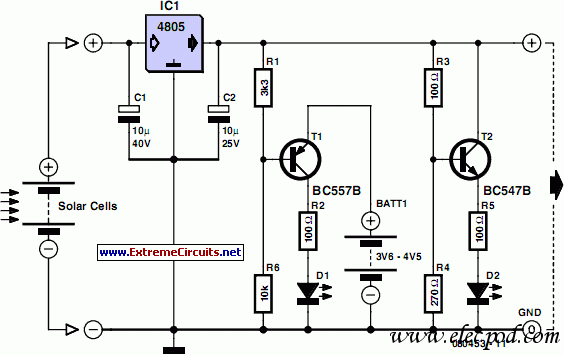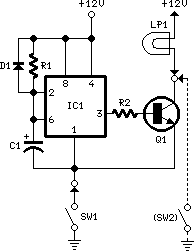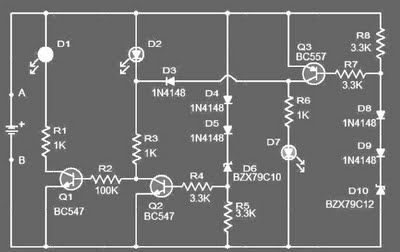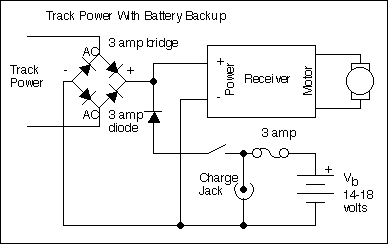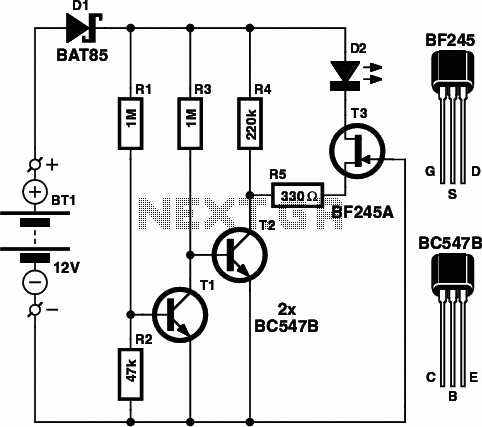
Battery charging regulator
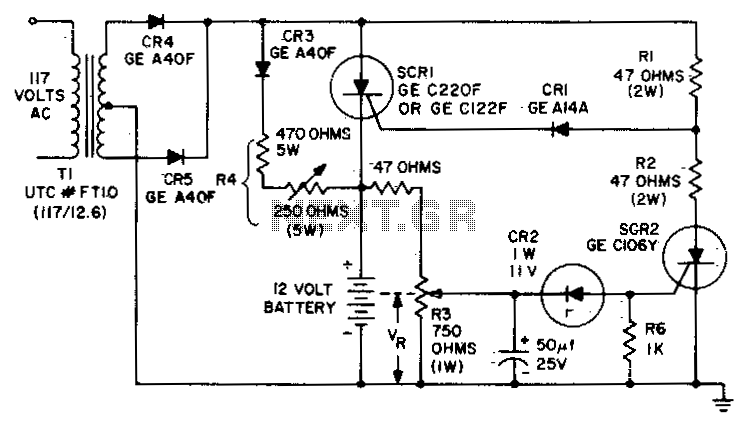
The circuit is designed to charge a 12-volt component selection at a maximum current of six amperes. Once the battery voltage reaches its fully charged level, the SCR shuts off, and a trickle charge, determined by the resistance value of R4, continues to flow.
The circuit operates by initially applying a charging voltage to a 12-volt battery. The charging current is regulated to a maximum of six amperes to prevent overheating and damage to the battery during the charging process. The SCR (Silicon Controlled Rectifier) serves as a key component in this circuit, acting as a switch that controls the flow of current to the battery. When the battery voltage reaches its fully charged state, the SCR is turned off, effectively halting the main charging current.
To maintain the battery's charge without overcharging, a trickle charge is introduced. This is achieved through a resistor denoted as R4 in the circuit. The value of R4 is critical, as it determines the amount of current that continues to flow into the battery after the SCR has been deactivated. The trickle charge serves to keep the battery topped off without risking damage from excessive voltage.
The circuit can be designed to accommodate a range of voltages and currents beyond the specified 12 volts and six amperes. With appropriate modifications, it can handle voltages from 6 to 600 volts and currents up to 300 amperes, making it versatile for various applications. This adaptability is achieved through the careful selection of components, including the SCR and resistors, to ensure they can safely manage the desired electrical parameters.
Overall, this charging circuit is a robust solution for maintaining battery health and longevity, utilizing both a primary charging phase and a secondary trickle charge phase to optimize battery performance.The circuit is capable of charging a 12 volt component selection. When the battery voltage battery at up to a six ampere rate Other volt- reaches its fully charged level, the charging ages and currents, from 6 to 600 volts and up to SCR shuts off, and a trickle charge as deter-300 amperes, can be accommodated by suitable mined by the value of R4 continues to flow.
The circuit operates by initially applying a charging voltage to a 12-volt battery. The charging current is regulated to a maximum of six amperes to prevent overheating and damage to the battery during the charging process. The SCR (Silicon Controlled Rectifier) serves as a key component in this circuit, acting as a switch that controls the flow of current to the battery. When the battery voltage reaches its fully charged state, the SCR is turned off, effectively halting the main charging current.
To maintain the battery's charge without overcharging, a trickle charge is introduced. This is achieved through a resistor denoted as R4 in the circuit. The value of R4 is critical, as it determines the amount of current that continues to flow into the battery after the SCR has been deactivated. The trickle charge serves to keep the battery topped off without risking damage from excessive voltage.
The circuit can be designed to accommodate a range of voltages and currents beyond the specified 12 volts and six amperes. With appropriate modifications, it can handle voltages from 6 to 600 volts and currents up to 300 amperes, making it versatile for various applications. This adaptability is achieved through the careful selection of components, including the SCR and resistors, to ensure they can safely manage the desired electrical parameters.
Overall, this charging circuit is a robust solution for maintaining battery health and longevity, utilizing both a primary charging phase and a secondary trickle charge phase to optimize battery performance.The circuit is capable of charging a 12 volt component selection. When the battery voltage battery at up to a six ampere rate Other volt- reaches its fully charged level, the charging ages and currents, from 6 to 600 volts and up to SCR shuts off, and a trickle charge as deter-300 amperes, can be accommodated by suitable mined by the value of R4 continues to flow.
